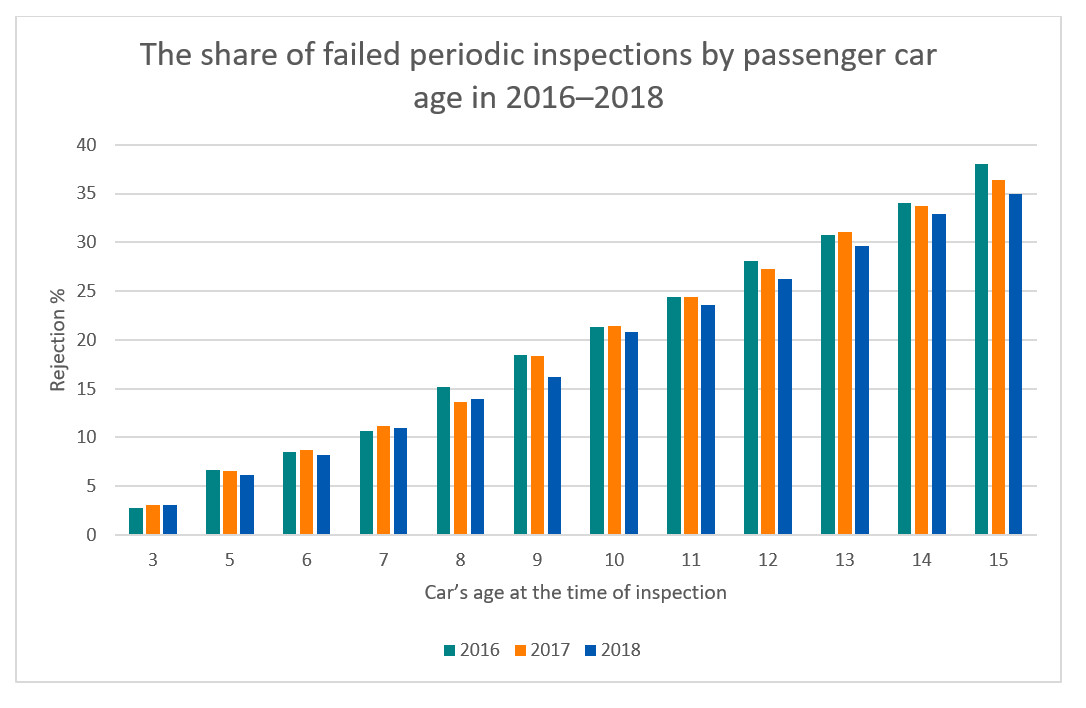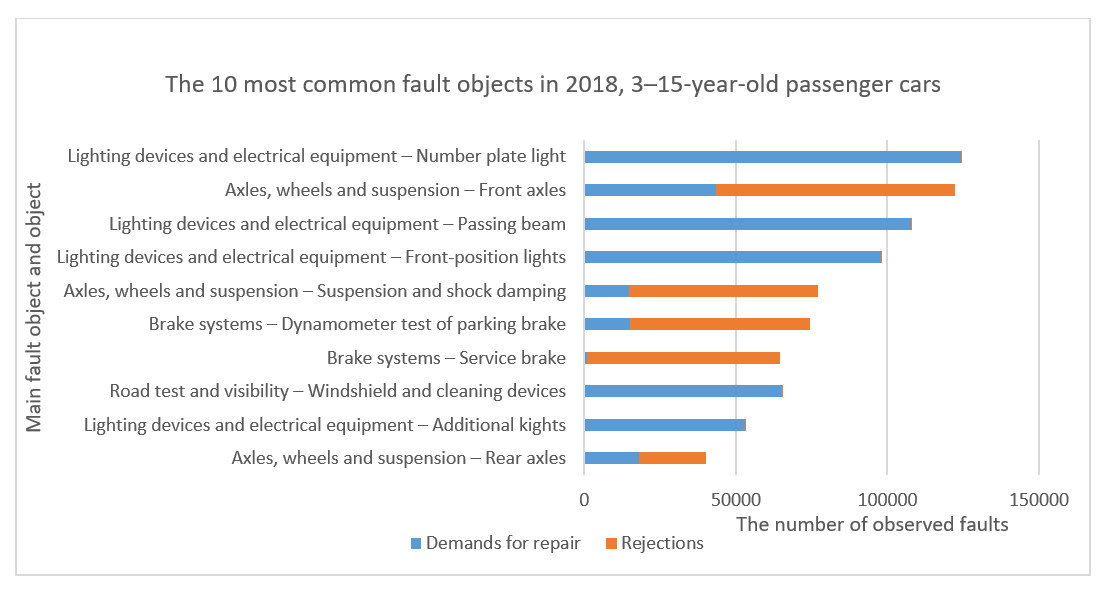Finnish Transport and Communications Agency Traficom published last years’ model-specific passenger car inspection fault statistics. As in previous years, the largest number of cars failed their inspection due to faults of the front axles, suspension, shock damping and brakes. 3.1% of cars failed their first inspection. In practice, the changes to legislation that entered into force in May 2018 result to, for example, faster removal of worn-out tyres from traffic.
In 2018, approximately 20% of 3–15-year-old cars were rejected in periodic inspection whereas the corresponding percentage was 20.6% in 2017. On average, 3.1% of cars failed their first inspection while in 2017, the corresponding percentage was 3%. Remarkable changes in the share of failed inspections have not taken place in recent years.

Similarly to last year, model-specific mileage is included in the inspection statistics. This enables finding correlations between the share of failed inspections and the average mileage for each car model. For the first time, the inspection statistics include the numbers of faults that led to demands for repairs, rejections and driving bans by registration year, model series and fault objects. The data is available in the database table Periodic inspections of cars by model and fault object in 2017 to 2018 (External link).
“The data enables examining the prevalence of different faults and comparing makes and models in terms of faults detected in inspections,” says Ari Väisänen, Special Adviser.
The most common causes of rejection for new cars lie in faults and deficiencies related to brakes. On the other hand, older cars get rejected most often because of front axle problems. Suspension and shock damping faults are also common grounds for rejection.

New inspection criteria entered into force in May 2018: emphasis on stricter control of tyre condition and brakes
New inspection intervals and criteria entered into force on 20 May 2018. The changed criteria have not had a visible effect on the number of rejected inspection decisions. Between 20 May 2018 and 31 December 2018, 25.2% of periodic inspections were rejected whereas in 2017, the share of rejections in the comparable time period was 26.2%.
By contrast, the number of driving bans has increased in comparison to last year. If the tread depth is too small (less than 1.6 mm), a driving ban is imposed as tyres this worn cause remarkable impacts on traffic safety. The inspection criteria related to brakes were made stricter as well. The fact that leaking brake fluid, remarkable brake drag and lack of braking efficiency directly cause the issuing of a driving ban has led to an increase in the number of driving bans.
“The purpose of periodic inspection is to determine whether a car has essential faults and defections that impact traffic safety. Most of the changes to the inspection criteria derive directly from the EU’s Inspection Directive," says Teemu Toivanen, Special Adviser.
In the time period between the new criteria’s entry into force and the end of the year, approximately 15,600 faults that led to a driving ban were observed whereas the number of such faults was 4,000 in the comparable time period in 2017.
Number of observed faults per 1,000 inspections
Severity | 20/05/2017–31/12/2017 | 20/05/2018–31/12/2018 |
Demand for repairs | 662 | 635 |
Rejection | 493 | 459 |
Driving ban | 3 | 12 |
Total | 1158 | 1106 |
* The number of faults may contain several faults occurring in a single car. |
With respect to the main objects Lighting devices and electrical equipment and Road test and visibility, the number of faults that led to a rejection have increased since the changes to the inspection criteria entered into force. In practice, the number of rejections related to passing beams, front-position lights and windshield condition, or faults that hinder traffic observation, increased in comparison to 2017.
The number of driving bans increased particularly with respect to the main objects Brake systems and Axles, wheels and suspension. On a more specific level, an increased number of driving bans were issued due to tread depth and parking brake condition.
“The condition of tyres and brakes has direct impacts on traffic safety, and every motorist should pay attention to them. For example, the condition of tyres should be checked on a regular basis,” says Toivanen.
Further information:
Inspection fault statistics 2018 (External link) (in Finnish)
Inspection statistics in Traficom’s database (External link)
Teemu Toivanen, Special Adviser, tel. +358 29 5345 530, teemu.toivanen(at)traficom.fi
Ari Väisänen, Special Adviser, tel. +358 29 5346 177, ari.vaisanen(at)traficom.fi (statistics)